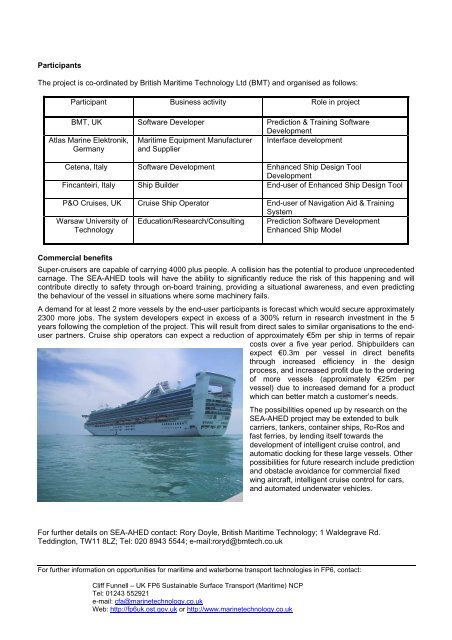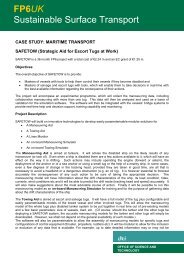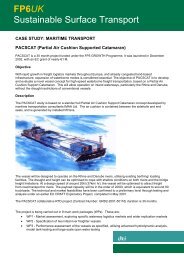CASE STUDY: MARITIME TRANSPORT - Marine Technology
CASE STUDY: MARITIME TRANSPORT - Marine Technology
CASE STUDY: MARITIME TRANSPORT - Marine Technology
Create successful ePaper yourself
Turn your PDF publications into a flip-book with our unique Google optimized e-Paper software.
Participants<br />
The project is co-ordinated by British Maritime <strong>Technology</strong> Ltd (BMT) and organised as follows:<br />
Participant Business activity Role in project<br />
BMT, UK Software Developer Prediction & Training Software<br />
Development<br />
Atlas <strong>Marine</strong> Elektronik,<br />
Germany<br />
Maritime Equipment Manufacturer<br />
and Supplier<br />
Interface development<br />
Cetena, Italy Software Development Enhanced Ship Design Tool<br />
Development<br />
Fincanteiri, Italy Ship Builder End-user of Enhanced Ship Design Tool<br />
P&O Cruises, UK Cruise Ship Operator End-user of Navigation Aid & Training<br />
System<br />
Warsaw University of<br />
<strong>Technology</strong><br />
Education/Research/Consulting Prediction Software Development<br />
Enhanced Ship Model<br />
Commercial benefits<br />
Super-cruisers are capable of carrying 4000 plus people. A collision has the potential to produce unprecedented<br />
carnage. The SEA-AHED tools will have the ability to significantly reduce the risk of this happening and will<br />
contribute directly to safety through on-board training, providing a situational awareness, and even predicting<br />
the behaviour of the vessel in situations where some machinery fails.<br />
A demand for at least 2 more vessels by the end-user participants is forecast which would secure approximately<br />
2300 more jobs. The system developers expect in excess of a 300% return in research investment in the 5<br />
years following the completion of the project. This will result from direct sales to similar organisations to the enduser<br />
partners. Cruise ship operators can expect a reduction of approximately €5m per ship in terms of repair<br />
costs over a five year period. Shipbuilders can<br />
expect €0.3m per vessel in direct benefits<br />
through increased efficiency in the design<br />
process, and increased profit due to the ordering<br />
of more vessels (approximately €25m per<br />
vessel) due to increased demand for a product<br />
which can better match a customer’s needs.<br />
The possibilities opened up by research on the<br />
SEA-AHED project may be extended to bulk<br />
carriers, tankers, container ships, Ro-Ros and<br />
fast ferries, by lending itself towards the<br />
development of intelligent cruise control, and<br />
automatic docking for these large vessels. Other<br />
possibilities for future research include prediction<br />
and obstacle avoidance for commercial fixed<br />
wing aircraft, intelligent cruise control for cars,<br />
and automated underwater vehicles.<br />
For further details on SEA-AHED contact: Rory Doyle, British Maritime <strong>Technology</strong>; 1 Waldegrave Rd.<br />
Teddington, TW11 8LZ; Tel: 020 8943 5544; e-mail:roryd@bmtech.co.uk<br />
For further information on opportunities for maritime and waterborne transport technologies in FP6, contact:<br />
Cliff Funnell – UK FP6 Sustainable Surface Transport (Maritime) NCP<br />
Tel: 01243 552921<br />
e-mail: cfa@marinetechnology.co.uk<br />
Web: http://fp6uk.ost.gov.uk or http://www.marinetechnology.co.uk




